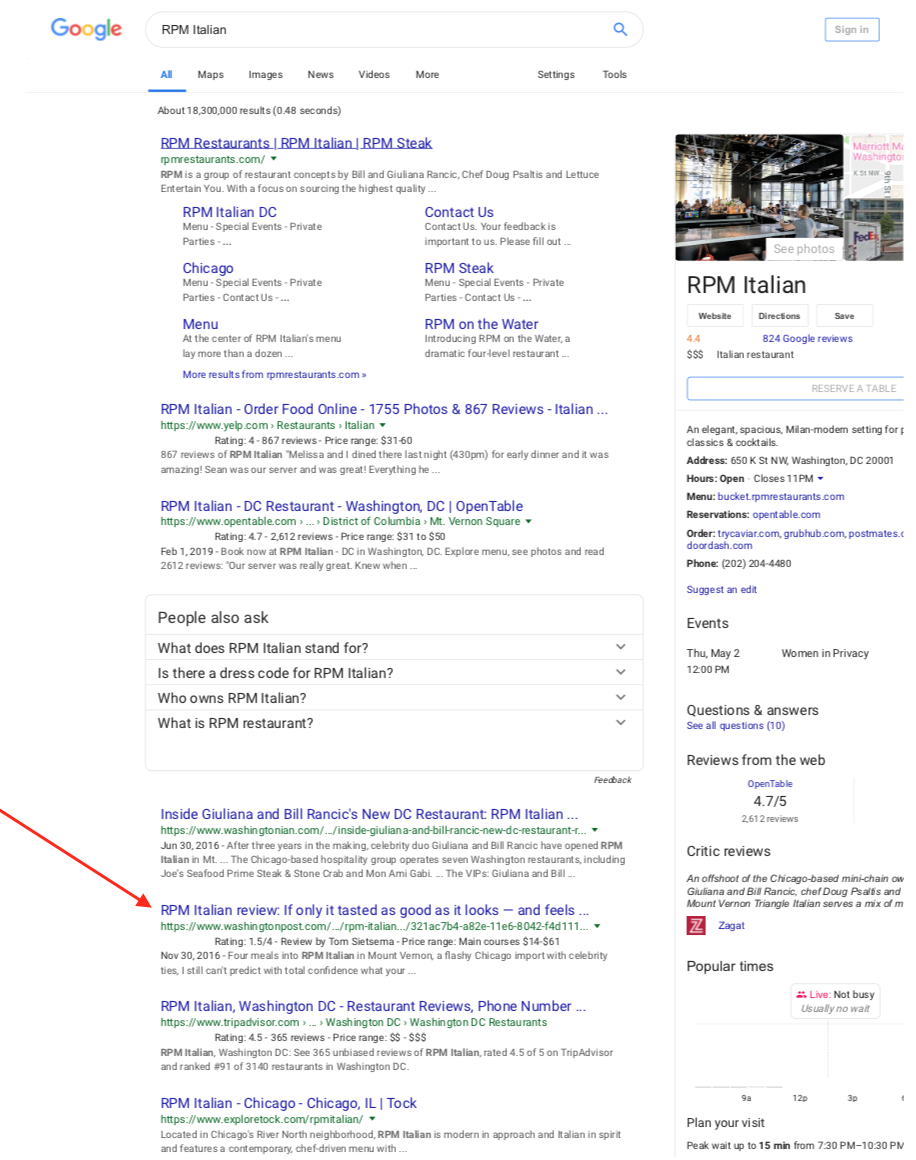At Go Fish Digital, one of our cornerstone verticals is Reputation Management. Our team begins by gathering the client information to then create a unique plan which is customized specifically to address that client’s needs. As our team is executing our strategic plan as well as accomplishing our goals, it’s common for our clients to come to us and ask what they can be doing to help our efforts in cleaning up their search results. My answer is almost always telling them that they don’t need to do anything and we’ve got this. I then say that they should utilize their internal team and make small and easy engagements to their positive URLs that they see ranking on pages one and two of their search results in order to help keep them relevant there. If Google doesn’t see any engagement signals to a page they may determine it’s not relevant for that query anymore. What are these small and easy engagements you ask? Here is my basic guide to reputation engagement to explain.
Related Content:
- Online Reputation Management
- Online Reviews Management
- Search Suppression Services
- Yelp Review Management
1. Do your own research
Search your keyword(s) and record what you see
Example
Let’s say my company is RPM Italian (one of my favorite Italian restaurants here in DC), and the search term I’m trying to watch is “RPM Italian”. After I search, I would start taking notes detailing what I see on pages one and two.
Page 1 Rankings:
- Main RPM Website with sitelinks & knowledge panel on the right-hand side of the page
- Yelp Review Profile
- OpenTable Review Profile
“people also ask” section - Washingtonian Article
- Tripadvisor Review Profile
- Washington Post Article
- Exploretock URL
Page 2 Rankings:
- ChicagoTribune URL
- Facebook Profile
- Twitter DC Profile
- Twitter Chicago Profile
- dc.eater URL
- Grubhub
- eonline URL
- Indeed Profile
- Zagat URL
- ChooseChicago URL
2. Identify your asset domains and your problem domains
Using the notes you took above, identify your positive areas (any domains you like or would like to see ranking higher), and then identify your problem areas (any domains you dislike or would like to see ranking lower)
Example
On pages one and two for “RPM Italian” we can see many positive URLs including Yelp, Opentable, Washingtonian URL, Tripadvisor, Exploretock, ChicagoTribune, Facebook, Twitter Profiles, dc.eater URL, GrubHub, eonline URL, Indeed, Zagat, and the ChooseChicago URL
As far as the URLs I don’t want ranking, personally, I would only be wary of the Washington Post review article – “RPM Italian Review: If only it tasted as good as it looks – and feels …”

3. Breakdown your asset domains into categories & find out internally who will engage with them
As we identified above we see that there are many positive assets that can be engaged with. If we break those down into categories, we find review sites, third-party articles/directory websites, social media profiles, and other owned domains.
Just as we did with these asset domains, break down your team into categories too. For example, find out who on your team has personally had an experience with the company and have them leave a review on a review website. Then, find out who is more active on social media platforms including, Facebook, Twitter, and Instagram, and line up tasks to have them share, like, and comment on these profiles. Additionally, have those members share the positive third-party URLs that are ranking below the problem area URL.
Example
Designate members of your team, that has had an experience at RPM, to write about it on one of the review sites. Find out which team members are active on social media and have them share one of the ‘third party’ URLs for their friends to engage with. Send team members to the restaurant to take photos and direct them to one of your reviews and/or social profiles to post about it.
Review sites: Yelp, OpenTable, TripAdvisor, GrubHub, Indeed
Owned Domain: RPM website
Social Profiles: Facebook, Twitter DC, Twitter Chicago
Other Third-Party Domains/Directories: Washingtonian article, exploretock, ChicagoTribune, dc.eater, eonline, Zagat, ChooseChicago

4. Don’t forget about other important areas and domains that aren’t ranking for your brand
Don’t forget about the other domains that you would like to see on pages one and two that you don’t see right now in your search results. For instance, if you don’t post to your Instagram page that often, make a note to engage with that page knowing that it has a high domain authority and could have good ranking potential for your brand.
My other point when I say ‘other important areas’ is to not forget about the sections on page one of your search results including the ‘people also ask’ and ‘knowledge panel’ sections. For example, you could leave a few positive Google reviews here (knowing Google cares more about the quantity of reviews over quality) and claim your knowledge panel, making sure all of the information there is up to date. You can also have your team give feedback to the ‘people also ask’ section.
Example
For RPM Italian, I immediately noticed that I’m not seeing their Instagram or their Glassdoor profile ranking at all. These are high DA sites that should not be forgotten about. When you’re listing out your domains into categories, don’t forget about those profiles you’re not seeing, because with some increased engagement to these pages, that could make a difference in helping the page move upward in your rankings as well as even capturing some new followers along the way.
5. Schedule it out
Setup internal tasks with due dates – adding incentives if you have to – via email or utilizing any project management tools that will take less than 5 minutes to do. These tasks may include sharing, commenting, reviewing, liking and subscribing to the URLs you identified in Step 1.
While user engagement is just one of the many signals Google looks for when it comes to ranking factors, we find that it is a very important step to take in order to improve your online reputation. These are very small, yet helpful tasks your team can be doing to help make that difference you want to see in your overall branded search.
Search News Straight To Your Inbox
*Required
Join thousands of marketers to get the best search news in under 5 minutes. Get resources, tips and more with The Splash newsletter: